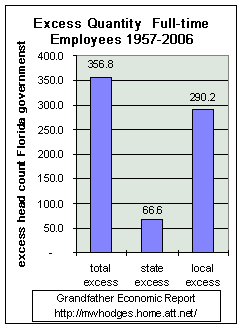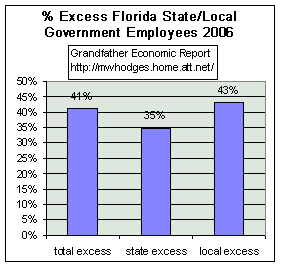Grandfather Economic Report series
HOME - Florida Report - Florida summary - E-mail author - Grandfather Economic Report
Florida Government Spending Report
FLORIDA STATE & LOCAL GOVERNMENT
EMPLOYEE HEADCOUNT SECTION
by Michael Hodges
- updated Dec. 2007 -
- a chapter of the Grandfather Economic Reports - |
5 Questions >
1. Should Florida's state and local governments become more efficient
over time, with increased productivity,
meaning their total headcounts should increase at a much slower rate of growth than does
the state population?
Yes, it should - - without any doubt !!
2. Does Florida's state & local government employees operate
at a lower percentage of the population than the past ??
Answer: ABSOLUTELY NOT !!!
3. Is there less government load per citizen than before?
Nope, the load is much higher !
4. Is the state nearly twice more government employee-dependent than
before?
Answer: Yes.
5. Is that fair to taxpayers? Nope !!
The Number of Florida's Government
Employees Increased Two Times Faster than Population Growth |
| From 1957 to 2006, Florida's population increased 302%, but the number of state &
local government employees increased 583%. Therefore it can be stated that there is a
357,000 employee headcount excess in Florida governments. |
| If state and local government employees in Floirda had delivered improved
productivity, as the private sector was doing, then their headcount totals (full-time
equivalents) would have increased less than the state's population growth from 1957-2006.
No such luck !!  The left chart shows state & local
government employees (full-time equivalents) increased in their numbers 71-100% faster the
State's population growth. The left chart shows state & local
government employees (full-time equivalents) increased in their numbers 71-100% faster the
State's population growth.
The state population increased from 4.5 million to 18 million 1957-2006 (302% increase)
- -
But, the number of state government employees increased 517% as per the left
chart (from 31,000 to 191,000)
And, the number of local government employees increased 604% (from 96,000 to
676,000)
If they had only increased at the same rate as the general population, there would have
been 357,000 fewer such employees in 2006. (67,000 excess state government employees and
290,000 excess in Florida's local governments) |
The following chart looks at this development from another
perspective. |
Florida Government Employee Counts
Increased 357,000 Too Much 1957-2006
( full-time equivalent headcount per 100 citizens per U.S. Census Bureau
) |
 The left chart (U.S. Census Bureau) shows full-time
equivalent Florida state & local employees per 100 citizens in the State - - from 1957
to 2006.
In 2006, each citizen had to carry 71% more Florida government employees on their
backs, than in did the1957 generation - as the quantity grew an extra 1.9 employees for
each 100 citizens (from 2.82 per 100 to 4.79).
As the State grew in population, efficient government should have grown at a slower
rate of employees. The 2006 ratio should have been less than the 2.82 of 1957 - - perhaps
closer to 2.00, but not 2.4 times larger.
But, they grew much faster than the population - showing negative efficiency.
Had 2006 been just as efficient as 1957, there would have been 357,000 fewer employees
as shown in the proceeding chart.
[In 1957 there were 127,000 full-time equiv. employees (31,000 state; 96,000 local). In
2006 there were 867,000 (191,000 state; 676,000 local governments)] |
The following chart shows the calculated excess quantity of
employees |
2006 Florida State & Local Government
Employee Percent Excess |
 Although the headcount should have grown at a rate slower than general
population if Florida's governments were well managed -
The left chart shows the total number full-time equivalent excess
state & local government employees had said growth been equal to population growth.
For example, in 2006 the number of state employees was 191,200. If the count since 1957
had risen at the same rate as state population growth then the total number of state
employees would have been 66,600 less than this. Regarding city/local government
employees, in 2006 that employee count was 676,100, or 290,200 more than would have been
the case if said growth had not exceeded population growth in that period.
To sumarize, this chart shows total excess = 356,800
employees in 2006 > >
- State government excess = 66,600
- Local government excess = 290,200
This data calculated from Census & Bureau Labor Statistics data used in above
charts. |
 This chart uses data from the prior chart, and computes the percentage
of excess employees to the existing headcount.
The total excess is 41% full-time equivalent employee count - - broken down
- Florida state government excess = 35%
- local government excess = 43%.
A head-count 41% cut from 2006 full-time equivalent employee counts would be required
to rebalance the headcount ratio to 2.8% of population, as achieved in the past.
An excuse cannot be made to discount the increase in education employees toward smaller
class sizes since study after study has shown that decreasing class size has zero impact
on output quality beyond the first grade. Additionally, if Florida followed the national
trend of tremendous inflation-adjusted per student spending increases in that period,
without provable improvement in measurable quality, then impact of education on Florida's
excess headcount ratio cannot be excused. (see the National Education Report).
In any case, it is interesting that the percent 'excess' is near the same for both
state and local government, regardless of the treatment of education. |
 The left chart shows the trend of the
excess employee headcount build-up, 1957-2006. Data is from the Census Bureau.
The red line, is the actual headcount trend, being the sum of state & local
government employees in Florida - rising from 127,000 in 1957 to 867,000 in 2006.
The dashed-black line is what the head counts would have been had they not increased
faster than general population growth since 1957 (holding steady at 2.8 employees per 100
citizens in population , and had there been zero productivity improvement. The totals
should not have exceeded 511,000 in 2006.
The difference between the lines, the excess headcount, is 357,000 employees - - or, 41%
too many.
If there had been increased efficiency & productivity, there should have been less
than 511,000 in 2006, but there were 867,000 - - AND, the red line on the chart should be
BELOW the black line.
Note - 2006 data shows this excess
employee count increased to 357,000 |
Whatever the 'excuses', the facts are today's young families in Florida must carry on
each of their backs many, many more government employees than did prior generations. And,
government employees have job security with wages and benefits protected from inflation
and better medical coverage as if it is a right - - not so with many from the private
sector.
The growth rate of Florida's total population is slowing down. It is even more
imperative that government spending and employee count ratios be targeted for significant
reductions. Since state & local government employees have been rising much faster than
the general population, and this is the very age group that is slowing down (of concern to
the demographic council of the Legislature) - then it is obvious that the non-government
employee portion of the State's population is under great pressure to finance this
government expansion. A reduction of government headcount and spending ratios, converting
same to the private sector, is required.
This extra 'overhead-baggage' does not increase the capacity of private sector families
to generate increased incomes and savings. In fact, by then end of the 1960's median
family incomes & savings rates ceased to rise, as shown in the Grandfather Family Income Report
Compared to the private sector, which has an incentive to produce productivity such
that more goods and services can be delivered per employee than ever before (banking,
manufacturing, mutual funds, autos, insurance, computers, etc.), governments in Florida
have produced NEGATIVE productivity. That's
clear evidence of the danger of non-competition. Family living standards growth can only
be achieved in an acceptable range if the economy enjoys positive productivity growth in
every area. Massive government is damaging the future.
The trends in Florida are steeper than the nation-wide average trends for state &
local government, as per the National
State & Local Government Report (https://grandfather-economic-report.com/state_local.htm
). It is highly recommended that the reader review this national report to gain a relative
wider perspective.
Then, it is recommended that the reader review the next report on Florida: The Florida Private Sector
Report
EMAIL author
TOP
 The left chart shows state & local
government employees (full-time equivalents) increased in their numbers 71-100% faster the
State's population growth.
The left chart shows state & local
government employees (full-time equivalents) increased in their numbers 71-100% faster the
State's population growth.


